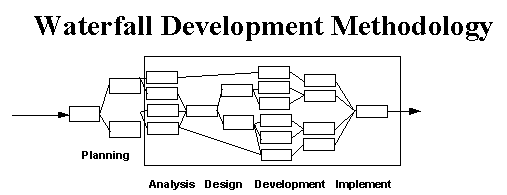
Figure 1
"The problem for engineers is that change translates into chaos, especially when a single error can potentially bring down an entire system. But, change also translates into opportunity. It's as simple as this: if there is time to put a certain amount of functionality into the product easily, then there is time to put in more functionality at the price of a certain amount of disruption and risk. Thus does madness creep into our projects - we will tend to take on as much risk as we possibly can."
James Bach. October 1995. "American Programmer"
Copyright 1995 Advanced Development Methods All Rights Reserved
In this paper we introduce a development process, SCRUM, that treats major portions of systems development as a controlled black box. We relate this to complexity theory to show why this approach increases flexibility and ability to deal with complexity, and produces a system that is responsive to both initial and additionally occurring requirements.
Numerous approaches to improving the systems development process have been tried. Each has been touted as providing "significant productivity improvements." None has. As Grady Booch noted, "We often call this condition the software crisis, but frankly, a malady that has carried on this long must be called normal."
Concepts from industrial process control are applied to the field of systems development in this paper. Industrial process control defines processes as either "theoretical" (fully defined) or "empirical" (black box). When a black box process is treated as a fully defined process, unpredictable results occur. A further treatment of this is provided in Appendix 1.
A significant number of systems development processes are not completely defined, but are treated as though they are. Unpredictability without control results. The SCRUM approach treats these systems development processes as a controlled black box.
The SCRUM approach is used at leading edge software companies with significant success. We believe SCRUM may be appropriate for other software development organizations to realize the expected benefits from Object Oriented techniques and tools.
Our new approach to systems development is based on both defined and black box process management. We call the approach the SCRUM methodology, after the SCRUM in rugby -- a group responsible for picking up the ball and moving it forward.
SCRUM is a management, enhancement and maintenance methodology for an existing system. SCRUM will address new or re-engineered systems development efforts at a later date.
Software product releases are planned based on the following variables :
These variables form the initial plan for a software enhancement project. However, these variables also change during the project. A successful development methodology must take these variables and their evolutionary nature into account.
Systems are developed in a highly complicated environment. The complexity is both within the development environment and the target environment. For example, when the air traffic control system development was initiated, three-tier client server systems and airline deregulation did not have to be considered. Yet, these environmental and technical changes occurred during the project and had to be taken into account within the system being built. Environmental variables include:
The overall complexity is a function of these variables :
complexity = f(development environment variables + target environment variables)
where these variables may and do change during the course of the project.
As the complexity of the project increases, the greater the need for controls, particularly the ongoing assessment and response to risk.
Attempts to model this development process have encountered the following problems:
Attempts to impose a micro, or detailed, methodology model on the development process have not worked because the development process is still not completely defined. Acting as though the development process is defined and predictable results in being unprepared for the unpredictable results.
Although the development process is incompletely defined and dynamic, numerous
organizations have developed detailed development methodologies that include
current development methods (structured, OO, etc.). The Waterfall methodology
was one of the first such defined system development processes. A picture of
the Waterfall methodology is shown in Figure 1.

Figure 1
Although the waterfall approach mandates the use of undefined processes, its linear nature has been its largest problem. The process does not define how to respond to unexpected output from any of the intermediate process.
Barry Boehm introduced a Spiral methodology to address this problem. Each of the waterfall phases is ended with a risk assessment and prototyping activity. The Spiral methodology is shown in Figure 2.
The Spiral methodology "peels the onion", progressing through "layers" of the development process. A prototype lets users determine if the project is on track, should be sent back to prior phases, or should be ended. However, the phases and phase processes are still linear. Requirements work is still performed in the requirements phase, design work in the design phase, and so forth, with each of the phases consisting of linear, explicitly defined processes.
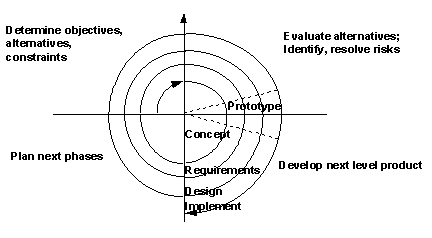
Figure 2
The Iterative methodology improves on the Spiral methodology. Each iteration consists of all of the standard Waterfall phases, but each iteration only addresses one set of parsed functionality. The overall project deliverable has been partitioned into prioritized subsystems, each with clean interfaces. Using this approach, one can test the feasibility of a subsystem and technology in the initial iterations. Further iterations can add resources to the project while ramping up the speed of delivery. This approach improves cost control, ensures delivery of systems (albeit subsystems), and improves overall flexibility. However, the Iterative approach still expects that the underlying development processes are defined and linear. See Figure 3.
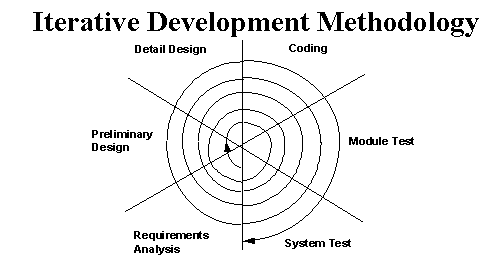
Figure 3
Given the complex environment and the increased reliance on new "state-of-the-art" systems, the risk endured by system development projects has increased and the search for mechanisms to handle this risk has intensified. One can argue that current methodologies are better than nothing. Each improves on the other. The Spiral and Iterative approaches implant formal risk control mechanisms for dealing with unpredictable results. A framework for development is provided.
However, each rests on the fallacy that the development processes are defined, predictable processes. But unpredictable results occur throughout the projects. The rigor implied in the development processes stifles the flexibility needed to cope with the unpredictable results and respond to a complex environment.
Despite their widespread presence in the development community, people don't use the methodologies except as a macro process map, or for their detailed method descriptions.
The following graph demonstrates the current development environment, using any of the Waterfall, Spiral or Iterative processes. As the complexity of the variables increase even to a moderate level, the probability of a "successful" project quickly diminishes (a successful project is defined as a system that is useful when delivered). See Figure 4.
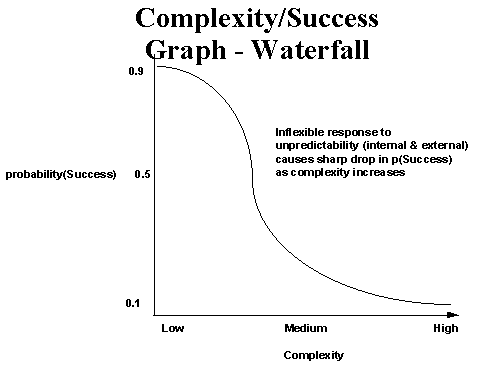
Figure 4
The system development process is complicated and complex. Therefore maximum flexibility and appropriate control is required. Evolution favors those that operate with maximum exposure to environmental change and have maximized flexibility. Evolution deselects those who have insulated themselves from environmental change and have minimized chaos and complexity in their environment.
An approach is needed that enables development teams to operate adaptively within a complex environment using imprecise processes. Complex system development occurs under chaotic circumstances. Producing orderly systems under chaotic circumstances requires maximum flexibility. The closer the development team operates to the edge of chaos, the more competitive and useful the resulting system will be.
Methodology may well be the most important factor in determining the probability of success. Methodologies that encourage and support flexibility have a high degree of tolerance for changes in other variables. With these methodologies, the development process is regarded as unpredictable at the onset, and control mechanisms are put in place to manage the unpredictability.
If we graph the relationship between environmental complexity and probability of success with a flexible methodology that incorporates controls and risk management, the tolerance for change is more durable. See Figure 5.
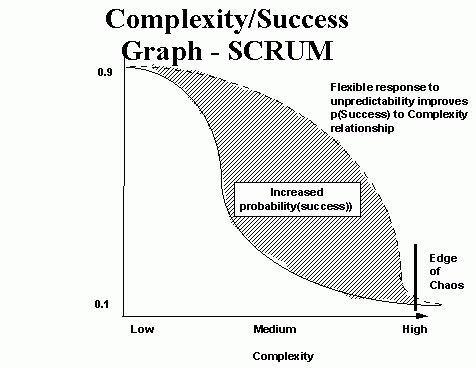
Figure 5
Figures 4 and 5 reflect software development experiences at ADM, Easel, Vmark, Borland and virtually every other developer of "packaged" software. These organizations have embraced risk and environmental complexity during development projects. Increased product impact, successful projects, and productivity gains were experienced. The best possible software is built.
Waterfall and Spiral methodologies set the context and deliverable definition at the start of a project. SCRUM and Iterative methodologies initially plan the context and broad deliverable definition, and then evolve the deliverable during the project based on the environment. SCRUM acknowledges that the underlying development processes are incompletely defined and uses control mechanisms to improve flexibility.
The primary difference between the defined (waterfall, spiral and iterative) and empirical (SCRUM) approach is that The SCRUM approach assumes that the analysis, design, and development processes in the Sprint phase are unpredictable. A control mechanism is used to manage the unpredictability and control the risk. Flexibility, responsiveness, and reliability are the results. See Figure 6.
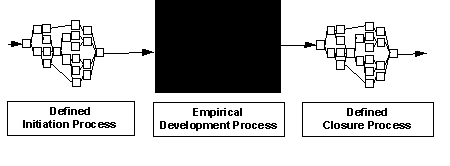
Figure 6
Characteristics of SCRUM methodology are :
Figure 7 compares the primary SCRUM characteristics to those of other methodologies.
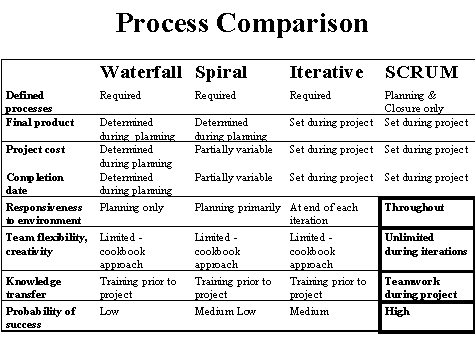
Figure 7
Planning : Definition of a new release based on currently known backlog, along with an estimate of its schedule and cost. If a new system is being developed, this phase consists of both conceptualization and analysis. If an existing system is being enhanced, this phase consists of limited analysis.
Architecture : Design how the backlog items will be implemented. This phase includes system architecture modification and high level design.
Development Sprints : Development of new release functionality, with constant respect to the variables of time, requirements, quality, cost, and competition. Interaction with these variables defines the end of this phase. There are multiple, iterative development sprints, or cycles, that are used to evolve the system.
Closure : Preparation for release, including final documentation, pre-release
staged testing, and release.
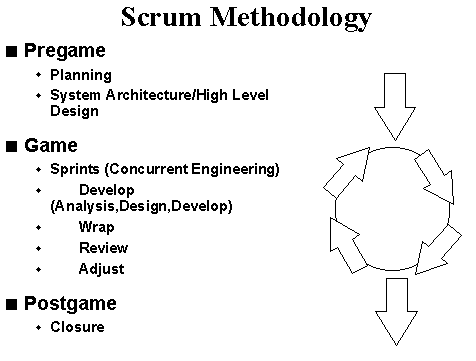
Figure 9
Each of the phases has the following steps:
Planning
Architecture/High Level Design
Development (Sprint) - the Development phase is an iterative cycle of development work. The management determines that time, competition, quality, or functionality are met, iterations are completed and the closure phase occurs. This approach is also known as Concurrent Engineering. Development consists of the following macro processes :
A Sprint is a set of development activities conducted over a pre-defined period, usually one or four weeks. The interval is based on product complexity, risk assessment, and degree of oversight desired. Sprint speed and intensity are driven by the selected duration of the Sprint. Risk is assessed continuously and adequate risk controls and responses put in place. Each Sprint consists of one or more teams performing the following:
Each Sprint is followed by a review, whose characteristics are :
Closure - When the management team feels that the variables of time, competition, requirements, cost, and quality concur for a new release to occur, they declare the release "closed" and enter this phase. This phase prepares the developed product for general release. Integration, system test, user documentation, training material preparation, and marketing material preparation are among closure tasks.
Operating at the edge of chaos (unpredictability and complexity) requires management controls to avoid falling into chaos. The SCRUM methodology embodies these general, loose controls, using OO techniques for the actual construction of deliverables.
Risk is the primary control. Risk assessment leads to changes in other controls and responses by the team.
Controls in the SCRUM methodology are :
These controls are used in the various phases of SCRUM. Management uses these controls to manage backlog. Teams use these controls to manage changes, problems. Both management and teams jointly manage issues, risks, and solutions. These controls are reviewed, modified, and reconciled at every Sprint review meeting.
The delivered product is flexible. Its content is determined by environment variables, including time, competition, cost, or functionality. The deliverable determinants are market intelligence, customer contact, and the skill of developers. Frequent adjustments to deliverable content occur during the project in response to environment. The deliverable can be determined anytime during the project.
The team that works on the new release includes full time developers and external parties who will be affected by the new release, such as marketing, sales, and customers. In traditional release processes, these latter groups are kept away from development teams for fear of over-complicating the process and providing "unnecessary" interference. The SCRUM approach, however, welcomes and facilitates their controlled involvement at set intervals, as this increases the probability that release content and timing will be appropriate, useful, and marketable.
The following teams are formed for each new release:
The SCRUM methodology is a metaphor for the game of Rugby. Rugby evolved from English football (soccer) under the intense pressure of the game :
Rugby student William Webb Ellis, 17, inaugurates a new game whose rules will be codified in 1839. Playing soccer for the 256-year-old college in East Warwickshire, Ellis sees that the clock is running out with his team behind so he scoops up the ball and runs with it in defiance of the rules. The People's Chronology, Henry Holt and Company, Inc. Copyright © 1992.
SCRUM projects have the following characteristics :
The SCRUM methodology shares many characteristics with the sport of Rugby :
Additional development methodologies are designed only to respond to the unpredictability of the external and development environments at the start of an enhancement cycle. Such newer approaches as the Boehm spiral methodology and its variants are still limited in their ability to respond to changing requirements once the project has started.
The SCRUM methodology, on the other hand, is designed to be quite flexible throughout. It provides control mechanisms for planning a product release and then managing variables as the project progresses. This enables organizations to change the project and deliverables at any point in time, delivering the most appropriate release.
The SCRUM methodology frees developers to devise the most ingenious solutions throughout the project, as learning occurs and the environment changes.
Small, collaborative teams of developers are able to share tacit knowledge about development processes. An excellent training environment for all parties is provided.
Object Oriented technology provides the basis for the SCRUM methodology. Objects, or product features, offer a discrete and manageable environment. Procedural code, with its many and intertwined interfaces, is inappropriate for the SCRUM methodology. SCRUM may be selectively applied to procedural systems with clean interfaces and strong data orientation.
SCRUM projects can be estimated using standard function point estimating. However, it is advisable to estimate productivity at approximately twice the current metric. The estimate is only for starting purposes, however, since the overall timetable and cost are determined dynamically in response to the environmental factors.
Our observations have led us to conclude that SCRUM projects have both velocity and acceleration. In terms of functions delivered, or backlog items completed :
Further development in metrics for empirical processes is required.
System development is the act of creating a logical construct that is implemented as logic and data on computers. The logical construct consists of inputs, processes, and outputs, both macro (whole construct) and micro (intermediate steps within whole construct). The whole is known as an implemented system.
Many artifacts are created while building the system. Artifacts may be used to guide thinking, check completeness, and create an audit trail. The artifacts consist of documents, models, programs, test cases, and other deliverables created prior to creating the implemented system. When available, a metamodel defines the semantic content of model artifacts. Notation describes the graphing and documentation conventions that are used to build the models.
The approach used to develop a system is known as a method. A method describes the activities involved in defining, building, and implementing a system; a method is a framework. Since a method is a logical process for constructing systems (process), it is known as a metaprocess (a process for modeling processes).
A method has micro and macro components. The macro components define the overall flow and time-sequenced framework for performing work. The micro components include general design rules, patterns and rules of thumb. General design rules state properties to achieve or to avoid in the design or general approaches to take while building a system. Patterns are solutions that can be applied to a type of development activity; they are solutions waiting for problems that occur during an activity in a method. Rules of thumb consist of a general body of hints and tips.
Applying concepts from industrial process control to the field of systems development, methods can be categorized as either "theoretical" (fully defined) or "empirical" (black box).
Correctly categorizing systems development methods is critical. The appropriate structure of a method for building a particular type of system depends on whether the method is theoretical or empirical.
Models of theoretical processes are derived from first principles, using material and energy balances and fundamental laws to determine the model. For a systems development method to be categorized as theoretical, it must conform to this definition.
Models of empirical processes are derived categorizing observed inputs and
outputs, and defining controls that cause them to occur within prescribed bounds.
Empirical process modeling involves constructing a process model strictly from
experimentally obtained input/output data, with no recourse to any laws concerning
the fundamental nature and properties of the system. No a priori knowledge
about the process is necessary (although it can be helpful); a system is treated
like a black box.
Upon inspection, we assert that the systems development process is empirical:
Most methodologists agree with this assertion; "...you can't expect a method to tell you everything to do. Writing software is a creative process, like painting or writing or architecture... ... (a method) supplies a framework that tells how to go about it and identifies the places where creativity is needed. But you still have to supply the creativity...."
Categorizing the systems development methods as empirical is critical to the effective management of the systems development process.
If systems development methods are categorized as empirical, measurements and controls are required because it is understood that the inner workings of the method are so loosely defined that they cannot be counted on to operate predictably.
In the past, methods have been provided and applied as though they were theoretical. As a consequence, measurements were not relied upon and controls dependent upon the measurements weren't used.
Many of the problems in developing systems have occurred because of this incorrect categorization. When a black box process is treated as a fully defined process, unpredictable results occur. Also, the controls are not in place to measure and respond to the unpredictability.